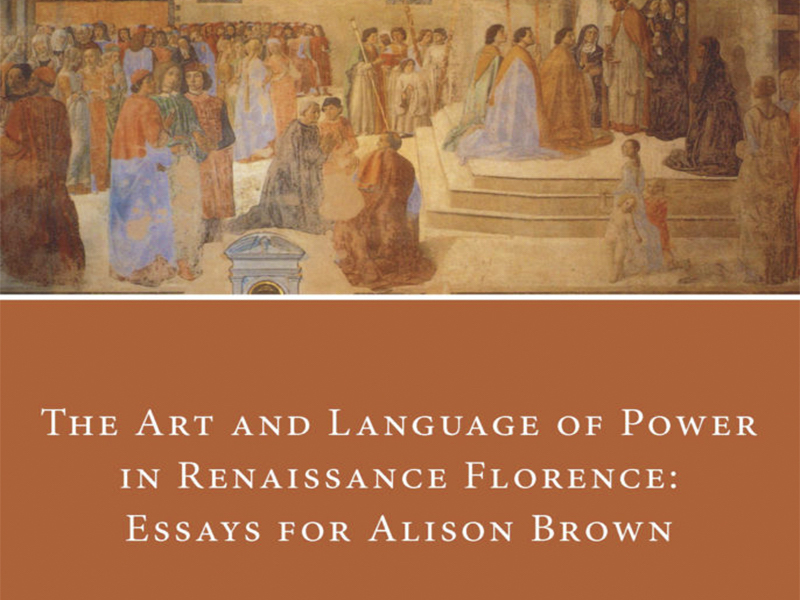On June 18, 2019 the Medici Archive Project in Florence hosted the presentation of The Art and Language of Power in Renaissance Florence: Essays for Alison Brown, edited by Amy R. Bloch, Carolyn James, and Camilla Russell. The volume (stemming from a symposium held in Prato at the local Monash University program in December 2015) is published by University of Toronto Press in the prestigious Series of the Centre for Reformation and Renaissance Studies.

Three speakers talked in turn about as many sections of the book. Firstly, Francesca Klein (Former Vice-Director of the Florence State Archives) introduced the volume by speaking about the preliminary essay by Roslyn Pesman (“Alison Brown and Late Fifteenth-Century Florentine History: An Appreciation”), John Najemy’s concluding essay (“Alison Brown’s Florentine Revolution”), and the third section of the book, titled “Humanism, the History of Ideas, and Intellectual Life: From Renaissance Florence to Twentieth-Century London”. This closing section includes two contributions by ISI Florence scholars: director Stefano Baldassarri’s essay on the humanist merchant, writer, and philosopher Giannozzo Manetti (“Feigning Ignorance: The Case of Giannozzo Manetti’s Against the Jews and Gentiles”) and history teacher Simone Testa’s essay on one of the secretaries of Cosimo I (‘“Che l’amore seguiti l’interesse”: The Language of Power in Giovanfrancesco Lottini’s Discorso sopra le attioni del conclave’). In highlighting Brown’s Renaissance studies legacy in Florence, Klein drew on Camilla Russell’s fascinating essay “The Renaissance Comes to Bloomsbury: Studies in the Italian Renaissance in Twentieth Century London”, which describes the cosmopolitan atmosphere of 1950s London as well as the seminars that were then held both at the Warburg Institute and the Institute of Historical Research. In the thriving milieu of post-war London, Brown was introduced to Renaissance studies by two “giants” in the field: Nicolai Rubinstein first, and Ernst Gombrich later. The latter, as Brown noted, taught her a critical approach that left nothing to “deterministic models of historical explanation that are divorced from the social and intellectual context” (p.397).
Secondly, Stefano Dall’Aglio (assistant professor at the University of Venice and Senior Fellow at The Medici Archive Project) commented on “The Political and Social Milieu of Renaissance Florence”, which is the section (consisting of no fewer than seven essays) that most directly addresses Brown’s research interests and legacy. These essays discuss – among other topics – Bernardo Machiavelli’s supposed illegitimate birth (Luca Boschetto), the Medici bank in Rome (Francesco Guidi-Bruscoli), women’s rights in the period of Lorenzo The Magnificent (Lorenzo Fabbri), social control and political consensus (Fabrizio Ricciardelli), and a new interpretation of Machiavelli’s famous sentence about the composition of the Discorsi: “altrove ne ragionai a lungo” (Jérémie Barthas).
Thirdly, Prof. Rita Comanducci (Art History, ISI Florence)argued that the four essays in the section “Art in Political and Ritual Contexts” show how, through art, the language of power impacts the politics of Renaissance Florence. In particular, Comanducci cited the late Riccardo Fubini’s original interpretation of the portico frieze in the Medici Villa at Poggio a Caiano. Fubini’s fascinating and groundbreaking interpretation looks at Kabbalistic themes as sources of inspiration behind the frieze. According to Fubini, the story represented in the frieze should be seen as inspired by Pico’s interest in the “eclectic interpretation of the sacred text” which was common in the early history of the Church (p.197).
To conclude, series editor Konrad Eisenbichler spoke about the overall project, its place in the series, and the relevance of Festschrifts for the dissemination of knowledge, especially when (as on this occasion) the essays provide clear testimony to the broad influence that Alison Brown’s research has had on her own as well as subsequent generations.
Simone Testa, Ph.D.
ISI Florence
